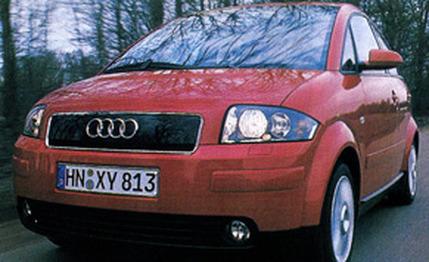
 First Drive Review
First Drive Review
Audi's recent popularity with Car and Driver editors is apparent and easily documented: The TT and the two top versions of the A6 made it onto this year's 10Best list, and in the May issue, the Audi A6 2.7T Quattro beat all comers in our comparison test of $40,000 sports sedans.
Now, back home in Germany, Audi is concentrating on a model that will never make our 10Best list because it will likely never be sold in the U.S. Its new A2 is neither sporty nor stylish. It does not have the unmatched interior ambiance of Audi's other models. It is small -- 150.6 inches long -- and light, at about 2000 pounds.
This is Audi's economy model, giving 50 miles per gallon with its regular 74-hp, 1.4-liter 16-valve four-cylinder gasoline engine, 67 mpg with a three-cylinder turbo-diesel of similar displacement and power, and 80 mpg in an upcoming special version with a 1.2-liter diesel. That 80 mpg is the three-liters-per-100-kilometers consumption target the German manufacturers set for themselves to demonstrate they are serious about the environment.
The Audi A2 may be economical to operate, but it will not be particularly cheap to buy. The price in Europe is equivalent to that of a well-outfitted Volkswagen Golf. That is not surprising when you see how it is made, because this is the first modern volume-production car to have a body and space-frame chassis in aluminum. This technology, pioneered by Audi for its flagship A8 sedan and since adopted by BMW for the Z8 sports car, has progressed to the point where it can be used to make 60,000 A2s a year.
Audi admits the A2 is primarily a technology project. We can admire what it has achieved but wonder why it has done it and, more particularly, who is going to buy it. The A2, a graceless five-door hatchback (with the highly purposeful drag coefficient of 0.28), really has only one competitor in Europe: the Mercedes A-class.
The baby Benz is a sales success in Europe despite its early handling troubles and its maker's realization that it would have been better if it had been 15 percent bigger -- as it will be in its next generation, which is reportedly headed for the U.S. Arguably the A-class sells more because it is the least expensive way of obtaining a new car with Mercedes' three-pointed star than for its practical or dynamic qualities.
In many respects the Audi A2 is a better car. Its steering and handling are much like those of most other small hatchbacks, including Audi's own front-drive A3, and thanks to its lower weight, it is quicker and more economical than the Mercedes A140.
But, while driving the A2, there is no way of knowing that you are in a car built around a framework of welded and riveted aluminum, its body sides (that weigh just 10.6 pounds) fixed by the latest laser-welding techniques and supported by immensely complex vacuum-cast pillars. Audi knows that even customers for the A8 choose it because it is a smart luxury car, not because its hull is aluminum.
As clever as it is in manipulating and fixing the material, Audi cannot get away from the fact that aluminum is two-and-a-half times more expensive than steel. The benefit is a 330-pound weight saving compared with a conventional steel-bodied car. Although it is slightly bigger than the Mercedes A-class, the gasoline-engined A2 weighs 250 pounds less than the A140. Unfortunately, the 1.4-liter diesel engine is weighty enough to cancel out much of the advantage -- that car tips the scales at 2200 pounds.